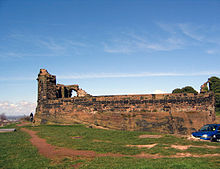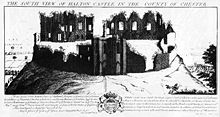Halton Castle (Cheshire)
Halton Castle is a ruined castle in the former village of Halton , now part of the town of Runcorn in the English county of Cheshire . The ruin is located on the summit plateau of Halton Hill, a sandstone hill above the village. English Heritage has listed it as a Grade I Historic Building. It is also considered a Scheduled Monument .
The castle was the seat of the Barons Halton from the 11th to the 14th centuries and then fell to the Duchy of Lancaster . In the English Civil War it was besieged twice. Then it fell into disrepair. In the 18th century a new courthouse was built in place of an earlier gatehouse . With the exception of the courthouse, the castle is now in ruins. The former courthouse is now a pub .
history
Construction and administration
Even if there is no more evidence of this today, it can be assumed that there was a prehistoric settlement on Halton Hill . After the Norman conquest of England , Hugh Lupus , Earl of Chester , founded the Halton Barony. Nigel of Cotentin was appointed as the first baron and it is very likely that he had a wooden moth built on this site , although the excavations in 1986–1987 did not reveal any evidence of a moth, wooden tower or palisade . Most likely, the wooden castle was replaced by one made of locally broken sandstone in the course of the 12th century , although no written evidence has been found for this either. Details of this building are unknown, but it is believed that John of Gaunt , the 14th Baron, remodeled the castle. However, this was not documented either. The castle became the property of the Duchy of Lancaster when Henry Bolingbroke, the 15th century baron, came to the throne of England when Henry IV .
The oldest document of building activity on Halton Castle shows that the castle was maintained regularly in the 15th century and into the 16th century. A new gatehouse was built between 1450 and 1457. There is no evidence that the castle played a role in the Wars of the Roses . This would have been unlikely because of their relatively hidden location. But a report on the royal palaces from 1609 shows that the castle was already in ruins by then. In the Tudor period , the castle no longer served as a fortress, but rather as a prison, administrative center and courthouse. In 1580 and 1581 the castle was designated as a prison for people who insisted on their Catholic faith and did not want to join the Anglican Church. However, there is no evidence that the castle was ever actually used in this way.
Royal visits
There is little evidence of visits by high-ranking figures to the castle, although it is believed that King John Ohneland paid a visit to the castle in 1207 and contributed £ 5 to maintain its chapel. King Edward II visited the castle safely and stayed there for three days in November 1323. During this time he also visited the Norton Priory .
Civil war
When the English Civil War broke out, Halton Castle was garrisoned by royalists under the command of Captain Walter Primrose , who had been appointed by Earl Rivers . The castle was besieged in 1643 by parliamentary troops under Sir William Brereton and the royalists surrendered after several weeks of siege. When it became known that overpowering royalist troops led by Prince Ruprecht were on the march, the Roundheads gave up the castle and it was occupied again by the royalists under Colonel Fenwick . There was a second siege in 1644, but when the fortunes of war left the royalists on other battlefields, they vacated Halton Castle and the parliamentarians under William Brereton moved in again. 1646 a "Council of War" was held in Warrington , where it was decided to grind the fortifications of Halton Castle and Beeston Castle . This was soon carried out and so the castle no longer had any military significance. In 1650 the castle was described as “badly dilapidated”.
Younger story
The castle continued to deteriorate, although the gatehouse continued to be used as a courthouse. In 1728 George Cholmondeley, 2nd Earl of Cholmondeley , leased the property from the Crown. In 1737 a new courthouse was built on the site of the medieval gatehouse. Henry Sephton , an architect from Liverpool , and John Orme , a cabinet maker from Prescot , were commissioned to carry out the work. The courtroom was on the upper floor and the prison on the first floor. In 1792 the courthouse fell into disrepair and money was found to renovate it. The source of the money is not known, however. The court sat there until 1908.
Around 1800, three folly walls were added to the ruined walls on the east side of the castle ruins to make it look even more impressive from Norton Priory, the home of Sir Richard Brooke . One of these walls was demolished around 1906. In the Victorian era , a sunken garden and two bowling greens were created within the castle walls . In 1977 the castle ruins were leased to the Halton local authority. In 1986 and 1987 excavations were carried out on the castle grounds.
Current condition
The castle ruins remain owned by the Duchy of Lancaster and the property is managed by the Norton Priory Museum Trust . The interior of the castle ruins is occasionally open to the public and there are plans to expand the viewing options in the future. The castle ruin is a historical building of the first degree. The walls are in ruins, but the periphery is intact. You can walk all around the castle ruins. From the elevated position you can see the country far in all directions. B. Lancashire , Cheshire, the Pennines , the hills of the Peak District National Park and the mountains of North Wales . The courthouse is now a pub. English Heritage has it as a historical building II *. Grade listed.
Individual evidence
- ↑ a b Halton Castle . Historic England. Retrieved November 23, 2015.
- ↑ Halton Castle: A ruined shell keep castle on the site of an earlier motte and bailey . Historic England. Retrieved November 23, 2015.
- ↑ a b H. F. Starkey: Old Runcorn . Halton Borough Council, Runcorn 1990. p. 32.
- ^ HF Starkey: Old Runcorn . Halton Borough Council, Runcorn 1990. p. 2.
- ↑ Arthur Whimperley: Halton Castle: An Introduction & Visitors' Handbook . Arthur Whimperley, Widmes 1981. p. 3.
- ^ A b Robina McNeil (editor): Halton Castle, a Visual Treasure . North West Archaeological Trust, Halton 1987. p. 1.
- ^ HF Starkey: Old Runcorn . Halton Borough Council, Runcorn 1990. p. 19.
- ^ Charles Nickson: History of Runcorn . Mackie & Co., London 1887. p. 146.
- ↑ a b c d e Robina McNeil (editor): Halton Castle, a Visual Treasure . North West Archaeological Trust, Halton 1987. p. 7.
- ^ HF Starkey: Old Runcorn . Halton Borough Council, Runcorn 1990. p. 28.
- ^ A b Charles Nickson: History of Runcorn . Mackie & Co., London 1887. p. 148.
- ^ HF Starkey: Old Runcorn . Halton Borough Council, Runcorn 1990. pp. 24-29.
- ^ Robina McNeil (editor): Halton Castle, a Visual Treasure . North West Archaeological Trust, Halton 1987. p. 8.
- ^ A b Charles Nickson: History of Runcorn . Mackie & Co., London 1887. p. 145.
- ^ HF Starkey: Old Runcorn . Halton Borough Council, Runcorn 1990, p. 58.
- ^ Charles Nickson: History of Runcorn . Mackie & Co., London 1887. p. 149.
- ^ Robina McNeil (editor): Halton Castle, a Visual Treasure . North West Archaeological Trust, Halton 1987. p. 9.
- ^ HF Starkey: Old Runcorn . Halton Borough Council, Runcorn 1990, p. 70.
- ^ Robina McNeil (editor): Halton Castle, a Visual Treasure . North West Archaeological Trust, Halton 1987. pp. 9, 11.
- ↑ Arthur Whimperley: Halton Castle: An Introduction & Visitors' Handbook . Arthur Whimperley, Widmes 1981. p. 19.
- ^ Robina McNeil (editor): Halton Castle, a Visual Treasure . North West Archaeological Trust, Halton 1987. pp. 26-27.
- ↑ Arthur Whimperley: Halton Castle: An Introduction & Visitors' Handbook . Arthur Whimperley, Widmes 1981. S. i.
- ^ Robina McNeil (editor): Halton Castle, a Visual Treasure . North West Archaeological Trust, Halton 1987. pp. 21-28.
- ^ The Castle Hotel Public House . Historic England. Retrieved November 23, 2015.
literature
- Clare Hartwell, Matthew Hyde, Edward Hubbard, Nikolaus Pevsner: The Buildings of England . Chapter: Cheshire . Yale University Press, New Haven and London 1971. ISBN 978-0-300-17043-6 . P. 566.
Web links
Coordinates: 53 ° 19 '59.2 " N , 2 ° 41' 44.5" W.


